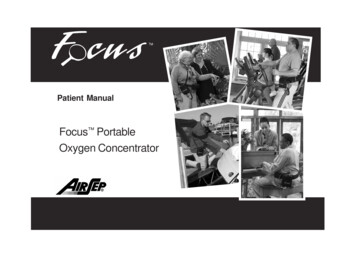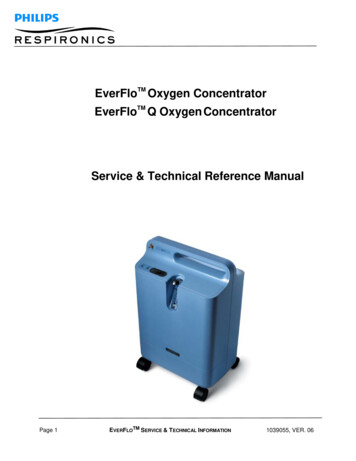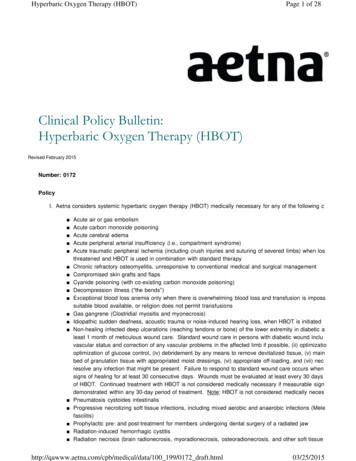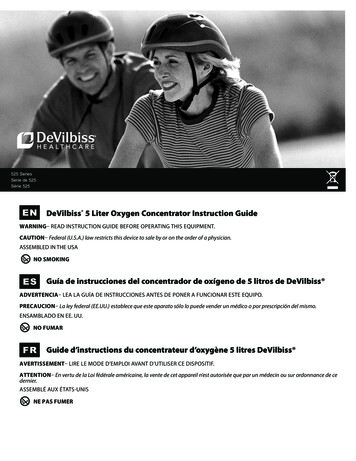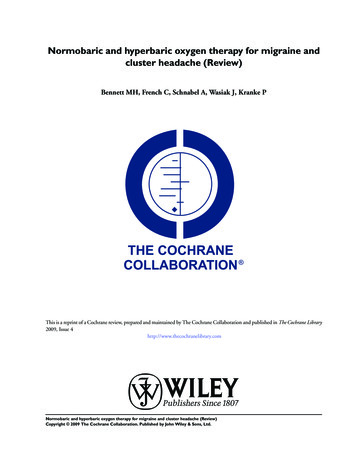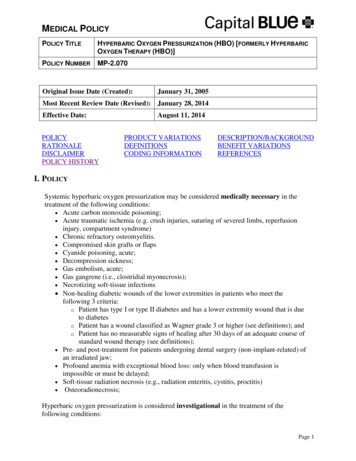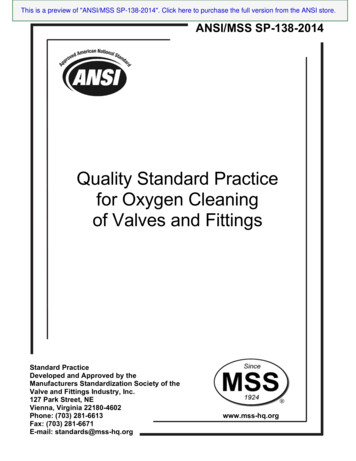
Transcription
This is a preview of "ANSI/MSS SP-138-2014". Click here to purchase the full version from the ANSI store.ANSI/MSS SP-138-2014Quality Standard Practicefor Oxygen Cleaningof Valves and FittingsStandard PracticeDeveloped and Approved by theManufacturers Standardization Society of theValve and Fittings Industry, Inc.127 Park Street, NEVienna, Virginia 22180-4602Phone: (703) 281-6613Fax: (703) 281-6671E-mail: standards@mss-hq.orgwww.mss-hq.org
This is a preview of "ANSI/MSS SP-138-2014". Click here to purchase the full version from the ANSI store.MSSSTANDARD PRACTICESP-138This MSS Standard Practice was developed under the consensus of the MSS Technical Committee 407 and the MSSCoordinating Committee. In addition, this Standard Practice was approved by an ANSI/MSS Consensus Committee andANSI as an American National Standard. The content of this Standard Practice is the resulting efforts of competent andexperienced volunteers to provide an effective, clear, and non-exclusive standard that will benefit the industry as a whole.This MSS Standard Practice describes minimal requirements and is intended as a basis for common practice by themanufacturer, the user, and the general public. The existence of an MSS Standard Practice does not in itself preclude themanufacture, sale, or use of products not conforming to the Standard Practice. Mandatory conformance to this StandardPractice is established only by reference in other documents such as a code, specification, sales contract, or public law, asapplicable. MSS has no power, nor does it undertake, to enforce or certify compliance with this document. Anycertification or other statement of compliance with the requirements of this Standard Practice shall not be attributable toMSS and is solely the responsibility of the certifier or maker of the statement.“Unless indicated otherwise within this MSS Standard Practice, other standards documents referenced toherein are identified by the date of issue that was applicable to this Standard Practice at the date of approvalof this MSS Standard Practice (see Annex A). This Standard Practice shall remain silent on the validity of thoseother standards of prior or subsequent dates of issue even though applicable provisions may not have changed.”By publication of this Standard Practice, no position is taken with respect to the validity of any potential claim(s) or of anypatent rights in connection therewith. MSS shall not be held responsible for identifying any patent rights. Users are expresslyadvised that determination of patent rights and the risk of infringement of such rights are entirely their responsibility.In this Standard Practice, all text, notes, annexes, tables, figures, and references are construed to be essential to theunderstanding of the message of the standard, and are considered normative unless indicated as “supplemental”. Allappendices, if included, that appear in this document are construed as “supplemental”. Note that supplementalinformation does not include mandatory requirements.The SI (metric) units and U.S. customary units in this Standard Practice are regarded separately as the standard;each should be used independently of the other. Combining or converting values between the two systems mayresult in non-conformance with this Standard Practice.This Standard Practice has been substantially revised from the previous 2009 edition. It issuggested that if the user is interested in knowing what changes have been made, that direct pageby page comparison should be made of this document and that of the previous edition.Non-toleranced dimensions in this Standard Practice are nominal unless otherwise specified.Excerpts of this Standard Practice may be quoted with permission. Credit lines should read ‘Extracted from ANSI/MSSSP-138-2014 with permission of the publisher, Manufacturers Standardization Society of the Valve and FittingsIndustry'. Reproduction and/or electronic transmission or dissemination is prohibited under copyright conventionunless written permission is granted by the Manufacturers Standardization Society of the Valve and Fittings IndustryInc. All rights reserved.Originally Approved: April 2008Originally Published: May 2009Current Edition Approved by MSS: July 2013Current Edition Approved by ANSI: July 2014Current ANSI/MSS Edition Published: December 2014MSS is a registered trademark of Manufacturers Standardization Society of the Valve and Fittings Industry, Inc.Copyright , 2014 byManufacturers Standardization Societyof theValve and Fittings Industry, Inc.Printed in U.S.A.i
This is a preview of "ANSI/MSS SP-138-2014". Click here to purchase the full version from the ANSI store.MSSSTANDARD PRACTICESP-138FOREWORDThis Standard Practice was developed by a cooperative effort of representatives of manufacturers whoproduce oxygen clean valves and fittings. It is based on the best practice current at this time and on thecollective experience of the industry.In 2013, this Standard Practice was revised by MSS and subsequently ANSI-approved as an AmericanNational Standard in 2014. This process involved an ANSI/MSS Consensus Committee that wascomposed of a diverse volunteer group of industry stakeholders with a material interest in the topic ofthis Standard Practice.ii
This is a preview of "ANSI/MSS SP-138-2014". Click here to purchase the full version from the ANSI store.MSSSTANDARD PRACTICESP-138TABLE OF CONTENTSSECTION1234567PAGEPURPOSE . 1SCOPE . 1GENERAL REQUIREMENTS . 1CLEANING . 1INSPECTION AND ACCEPTANCE CRITERIA . 2POST CLEAN ASSEMBLY AND TESTING . 3PACKAGING . 4MARKING . 4ANNEXAReferenced Standards and Applicable Dates . 5iii
This is a preview of "ANSI/MSS SP-138-2014". Click here to purchase the full version from the ANSI store.MSSSTANDARD PRACTICESP-138QUALITY STANDARD PRACTICE FOROXYGEN CLEANING OF VALVES AND FITTINGSPURPOSEThe purpose of this Standard Practice is toprovide standard methods for processing valvesand fittings intended to be used for OxygenService.2.6 Any special tests required for assembliesthat employ media that are incompatible withoxygen shall be performed before disassemblyfor cleaning.The proper combination of methods dependsupon the part, its method of manufacture, and thetypes of contamination present. It isrecommended that prior to implementation ofthis Standard Practice, an agreement be reachedbetween the purchaser and the productmanufacturer as to the appropriate methods to beused for the product to be cleaned.2.7 Cleaning, inspection, post-clean testing,and packaging shall be conducted by properlytrained and qualified personnel, knowledgeableof this Standard Practice and of the hazards andpotential ignition sources in oxygen systems.2.8 For additionalcleaning, refer to:guidanceonoxygen2.8.1 ASTM G93, Cleaning Methods andCleanliness Levels for Material and EquipmentUsed in Oxygen-Enriched Environments1. SCOPE1.1 This Standard Practice outlines the generalrequirements for cleaning, inspection, testing,and packaging of valves and fittings intended tobe used for Oxygen service.2.8.2 ASTM G127, Standard Guide for theSelection of Cleaning Agents for Oxygen Systems2.8.3 CGA G-4, Oxygen2.8.4 CGA G-4.1, Cleaning Equipment forOxygen Service1.2 Proper design and material compatibilityfor Oxygen systems is outside the scope of thisStandard Practice.3. CLEANING2. GENERAL REQUIREMENTS3.1 Cleaning must ensure the removal ofcontaminants(1) that can cause mechanicalmalfunction, fire, or explosion. Cleaning perthis Standard Practice will effectively removerust, loose scale, dirt, weld splatter, particles,grease and oil.2.1 Any cleaning agent used must becompatible with the material of the componentbeing cleaned.2.2 Chloride-free cleaning agents shall be usedon stainless steel. See Section 2.8 for additionalguidance.3.2 No single cleaning process will removeall potential ignition sources. Several cleaningmethods will need to be employed dependingupon the type of contamination present to passthe post-clean inspection.2.3 The handling, storage, and use of allchemicals shall be according to the instructionsgiven in their material safety data sheets(MSDS).2.4 Used cleaning solutions shall be disposedof in accordance with appropriate hazardouswaste regulations.NOTE: (1) The term contaminant refers tounwanted molecular, particulate, or chemicalmatter that could adversely affect or degrade theoperation, life, or reliability of the system(s) orcomponent(s) where it resides (e.g., amount ofcontamination; process or condition of beingcontaminated).2.5 Parts of assemblies shall be disassembledand separately cleaned before assembly canrender any surface inaccessible to cleaning andinspection.1
2.8.1 ASTM G93, Cleaning Methods and Cleanliness Levels for Material and Equipment Used in Oxygen-Enriched Environments 2.8.2 ASTM G127, Standard Guide for the Selection of Cleaning Agents for Oxygen Systems 2.8.3 CGA G-4, Oxygen 2.8.4 CGA G-4.1, Cleaning Equipment for Oxygen Service 3. CLEANING 3.1 Cleaning must ensure the removal of
